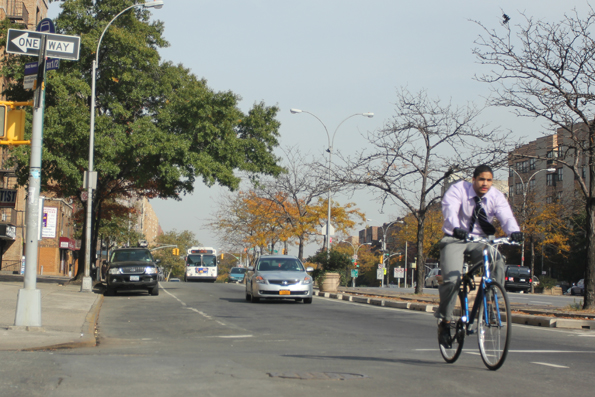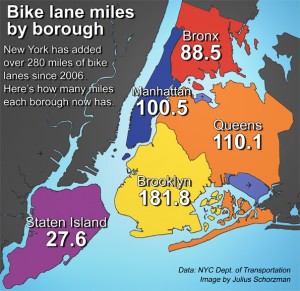Every morning Shardy Nieves rides his bicycle 11 miles from his home in Crotona to his job at Champion Courier on 37th Street and 7th Avenue in Manhattan. The 31-year-old Nieves said that he makes the ride, which takes almost an hour by subway, in 35 minutes.
“Faster than a train, less congestion,” said Nieves, who works in customer service at Champion Courier. “You can’t beat it.”
Still, he noted, cycling in Manhattan is far easier than in the Bronx. “Manhattan is more bike friendly,” Nieves said. “In the Bronx you have to fend for yourself.”
The Bronx has been pushed to the slow lanes in New York City’s current cycling renaissance. Not only does it have fewer miles of bike lanes than Brooklyn and Manhattan, and it is not yet included in the city’s ambitious bike sharing program.
The result is a cycling community that is smaller than the ones in Brooklyn and Manhattan, something that was on full display during the Oct. 23 Tour de Bronx.
The tour, an annual non-competitive bike ride through the borough, drew cyclists from all five boroughs. At the Yankee Stadium Number 4 station, riders from Manhattan and Brooklyn poured out of uptown trains in droves. Across the platform, a single cyclist came from the north Bronx, a symptom likely caused by the tip of the borough’s lack of bike lanes.
There are 88.5 miles of bike lanes in the Bronx, 56.5 of which have been added since 2006. Of the five boroughs, only Staten Island has fewer miles of bike lanes.
Lanes in the outer boroughs were placed in areas that provide easy access to midtown Manhattan. In Brooklyn and Queens, this means lanes in the waterfront communities of Williamsburg, Greenpoint, Long Island City and Astoria, respectively.
Similarly, most of the Bronx’s bike lanes have been placed in the South Bronx, in close proximity to the Harlem River bridges on streets like the Grand Concourse, Third, Walton and Jerome Avenues. The placement of the lanes on major streets has been a blessing and a curse for riders, who now have dedicated travel paths to Manhattan. But they have to be willing to weave through busy side streets in order to reach them.
Some cyclists choose not to deal with the threats of traffic, opting instead to take their bicycles on the subway. Jennie Heslin, who runs the New York City social bicycle club, had to get from her apartment in Morris Heights down to 161st Street for the Tour de Bronx. “I ended up taking my bike on the train,” Heslin said. “I wanted to avoid riding in the streets.”
It’s not uncommon to see cars parked in bike lanes, said Sebita Lekhraj, one of Heslin’s club members. “People don’t have any respect for bikers,” said Lekhraj, who also lives in Morris Park.
Dedicated bike lanes are not the only area where the Bronx rides behind Manhattan and Brooklyn. In September, the city debuted plans for an ambitious public bike-sharing program. The system, which calls for 600 stations and 10,000 bikes, will launch in September 2012 in Manhattan and Brooklyn.
Alta Bicycle Share, the company that will run the program, excluded the Bronx from the trial after conducting feasibility studies, but has indicated the possibility of establishing a smaller, disconnected satellite system in the borough at a later date.
Cycling has been a contentious issue in New York. The city began a push to increase the number of riding paths in 1997 with the release of the bike master plan. However bike lane construction didn’t begin in earnest until Mayor Michael Bloomberg arrived in 2001 and began championing the issue. In fact, Bloomberg made so much progress that disgraced former congressman Anthony Weiner, a mayoral frontrunner before a lewd photo scandal forced his resignation, once told the mayor that if elected, he’d spend his first year in office “tearing out your [expletive] bike lanes.”
In Brooklyn, Park Slope residents banded together to sue the city over a lane on Prospect Park West. The case was dismissed in August.
The Bronx hasn’t seen any similar uprisings, said Ben Fried, author of the alternative transportation website Streetsblog.org. “I’d be shocked if we heard a story like that,” Fried said.
While Brooklyn residents fume over bike lanes, Bronx residents seem to be rolling with the idea. A June 2011 poll showed that 63 percent of Bronx residents support bike lanes, a rate that tied with Manhattan for highest in the city. Some expect those numbers will grow.
“In terms of the number of people cycling, it’s not quite up there, but I think there’s a lot of people that don’t have cars, said Fried.”




